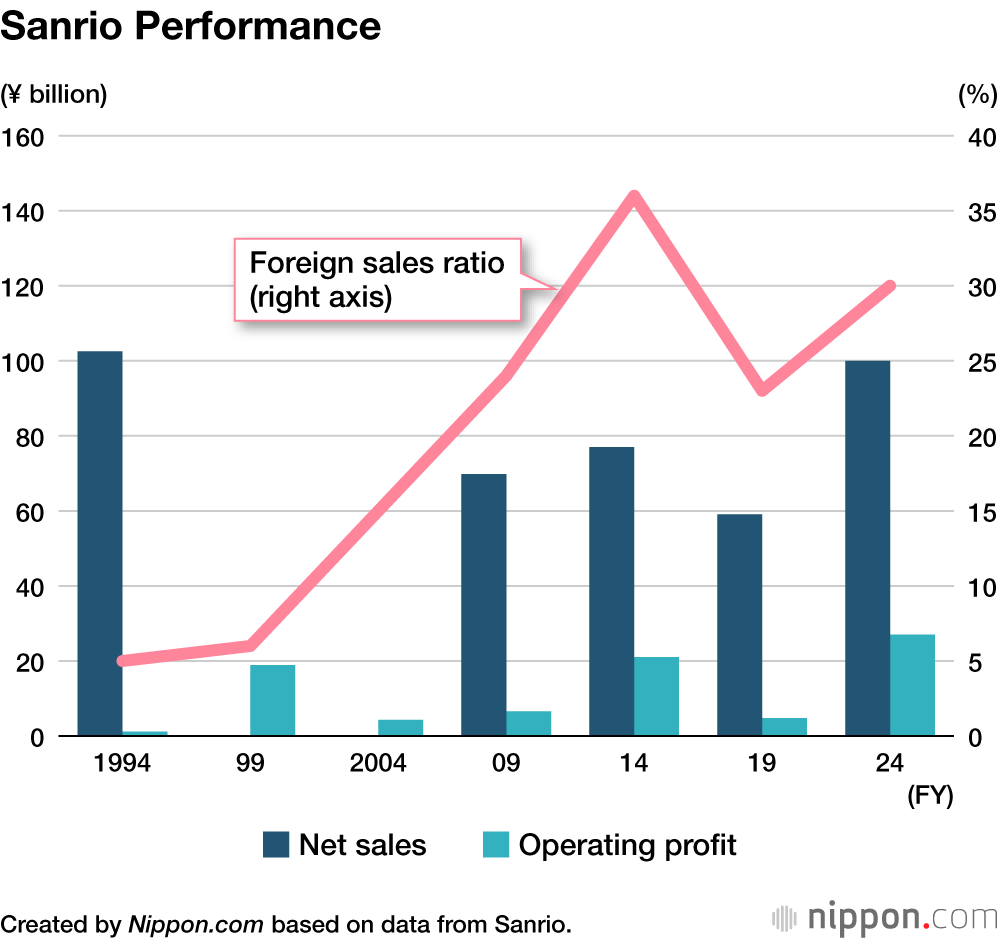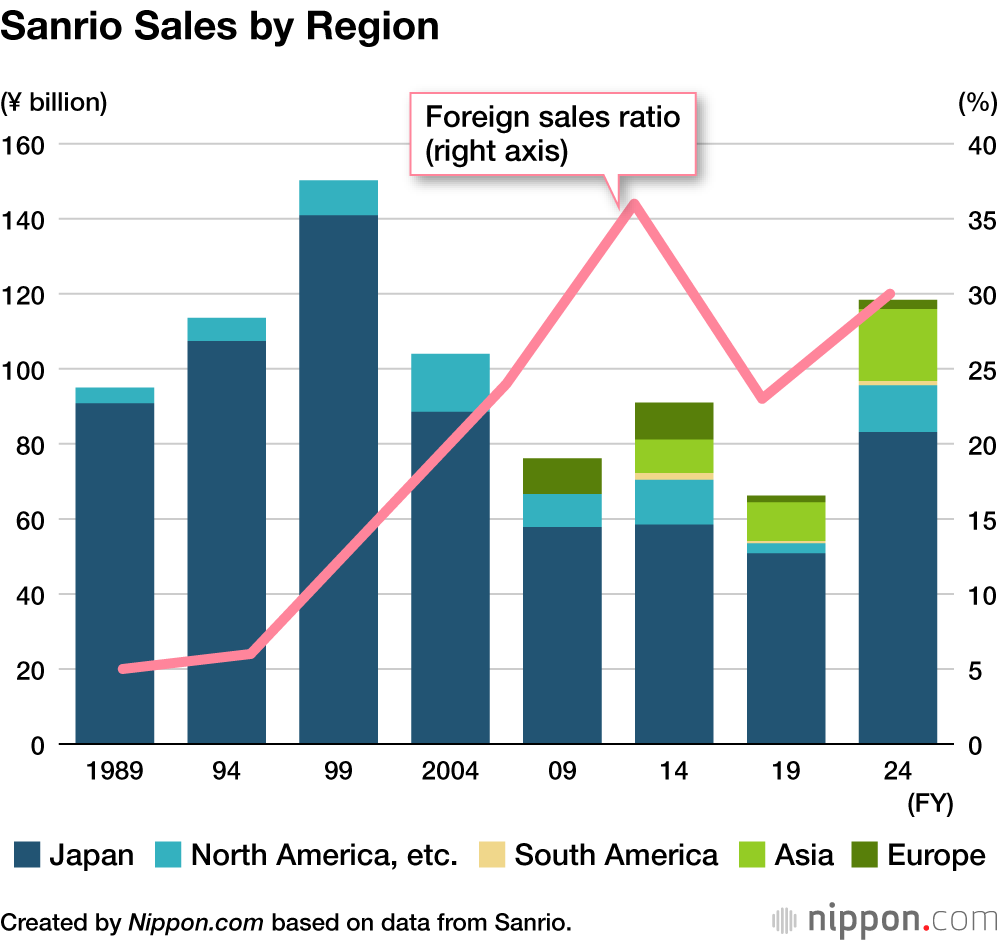
Hello Kitty at 50: Cute Simplicity a Winning Formula for Sanrio
Society Culture Economy- English
- 日本語
- 简体字
- 繁體字
- Français
- Español
- العربية
- Русский
Record Profits
The major birthdays of Hello Kitty (who was “born” on November 1, 1974) coincide uncannily with the performance milestones of her creator, Sanrio. In the fiscal year that ended in March 1999, in which Kitty turned 25, Sanrio reported its highest ever turnover of ¥150 billion. A decade and a half later, Kitty turned 40, and Sanrio reported a record 36% of sales from overseas markets and an all-time high operating profit of ¥22 billion for the year ended March 2014. While the company then saw its sales and profits decline for seven years, it posted an operating profit of ¥27 billion for the year ended March 2024 (surpassing its 2014 record), with a market capitalization of over ¥700 billion, ahead of Kitty’s fiftieth birthday.
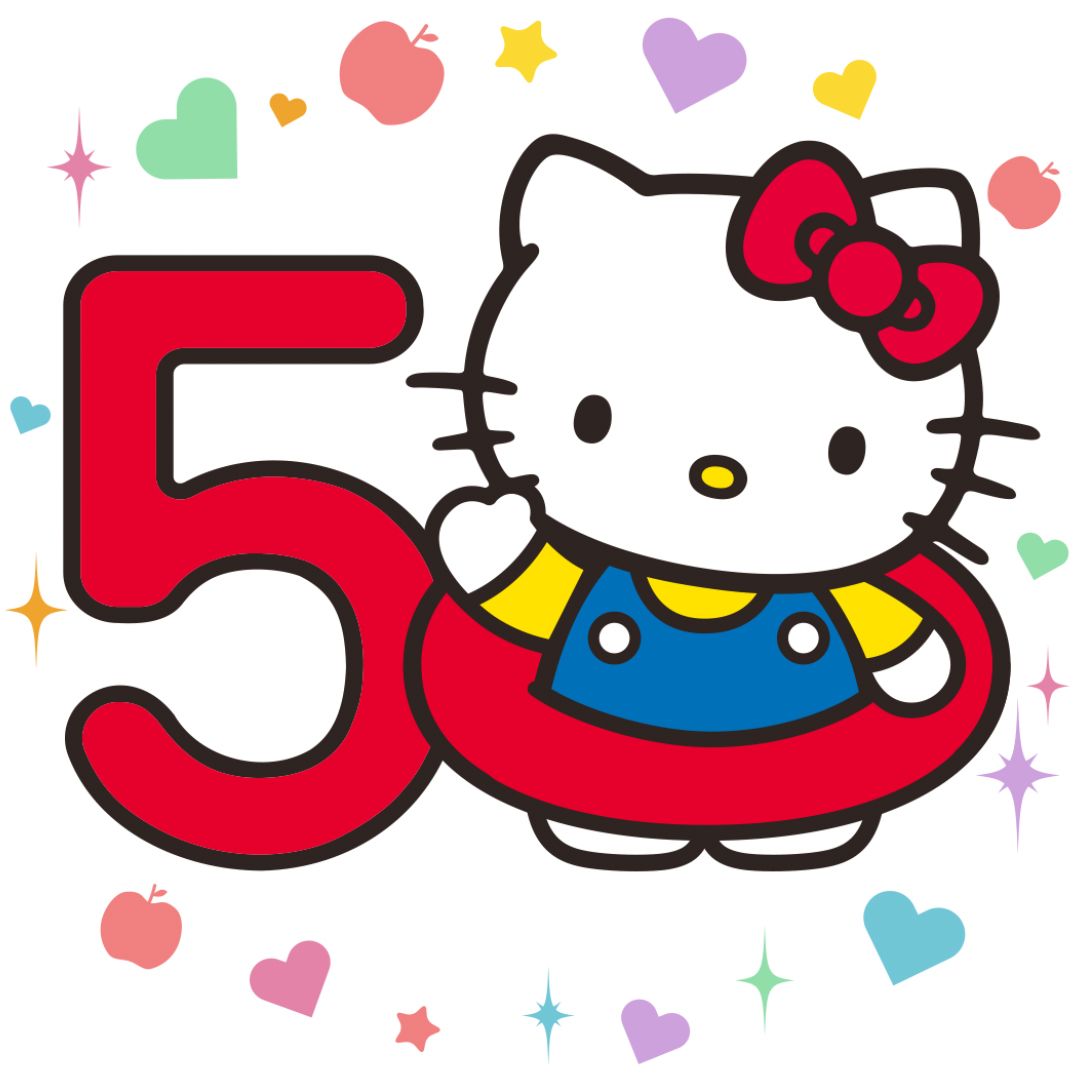
Hello Kitty celebrates her half century in 2024. (© 2023 Sanrio)
One factor in this dramatic recovery is the 2020 handover of power from CEO Tsuji Shintarō, then 92, to his 31-year-old grandson, Tsuji Tomokuni, in Sanrio’s first change of leadership since 1960. Another is the decreased prominence of the Hello Kitty range in Sanrio’s total sales over the past decade from 75% to just 50%, as the company broke away from its dependence on the character.
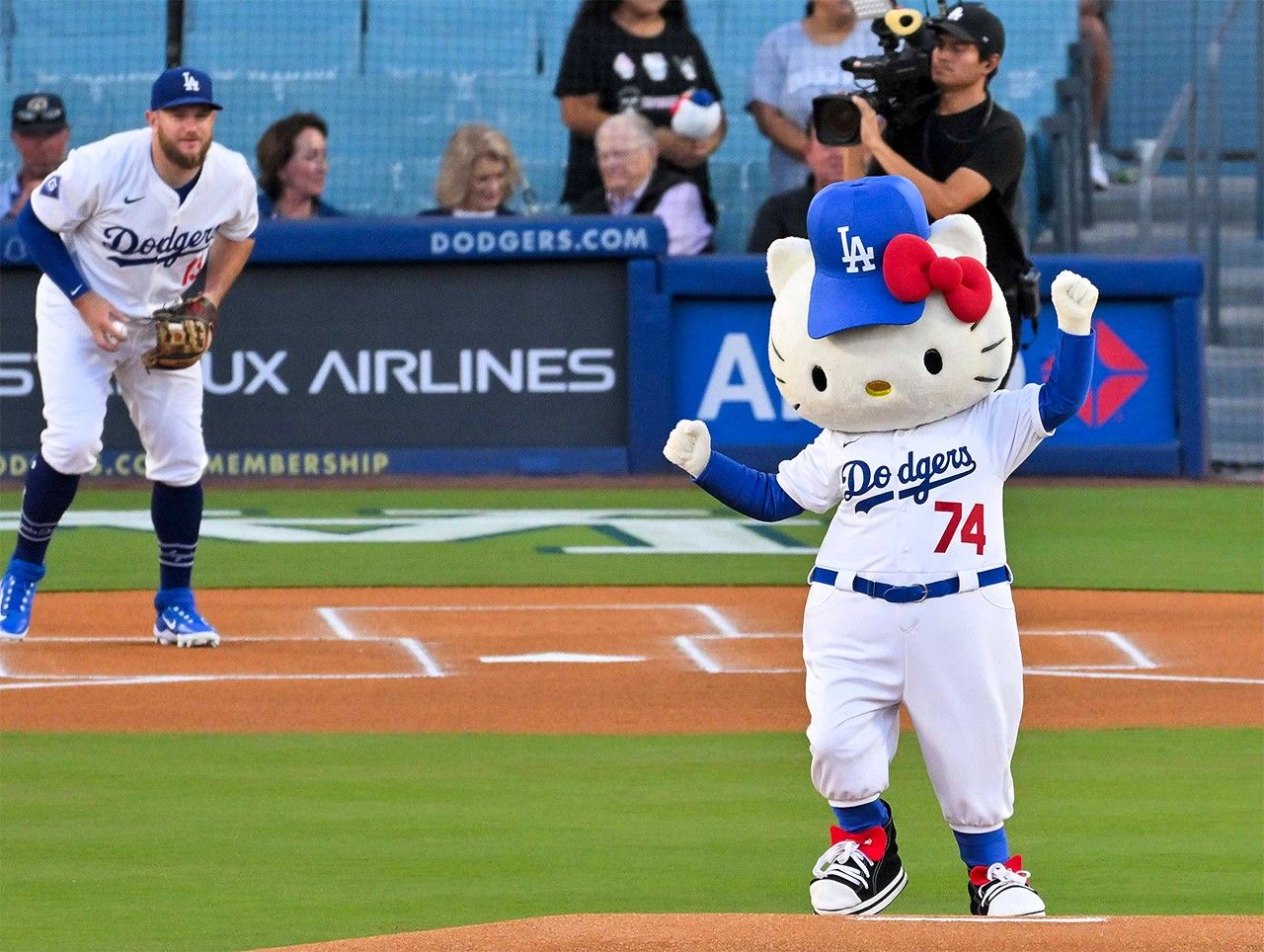
Hello Kitty appears at a Major League Baseball match between the Los Angeles Dodgers and the Seattle Mariners, making the ceremonial first pitch in Los Angeles on August 19, 2024. (© Jiji)
Chasing Sony
Initially trading as the Yamanashi Silk Center, Sanrio was established in Tokyo in 1960 by Tsuji Shintarō, who was employed by the Yamanashi prefectural government. The company initially sold silk products, wine, and other goods from Yamanashi.
In the 1960s, Japan was home to a budding culture built around fictional characters. In 1959, Disney had established its Japanese subsidiary, and Nintendo had released a hit range of playing cards emblazoned with pictures of Mickey Mouse and other Disney characters. In the 60s, toy and model marketer and importer/exporter Kokusai Bōeki Kaisha launched the Barbie doll in Japan, while Takara (now Takara Tomy) released its Licca-chan doll.
In 1962, Yamanashi Silk Center CEO Tsuji released a strawberry-patterned handkerchief, in a move that heralded the company’s entry into the merchandise market. On a mission to produce a complement of cute fictional characters, the company collaborated with an energetic group of artists. In the mid-1960s, it released a range of ceramic figurines and other products emblazoned with characters created by famous illustrator Mizumori Ado, and they proved to be a hit. In the 1970s, Sanrio began hiring its own designers, who would go on to create a range of unique characters.
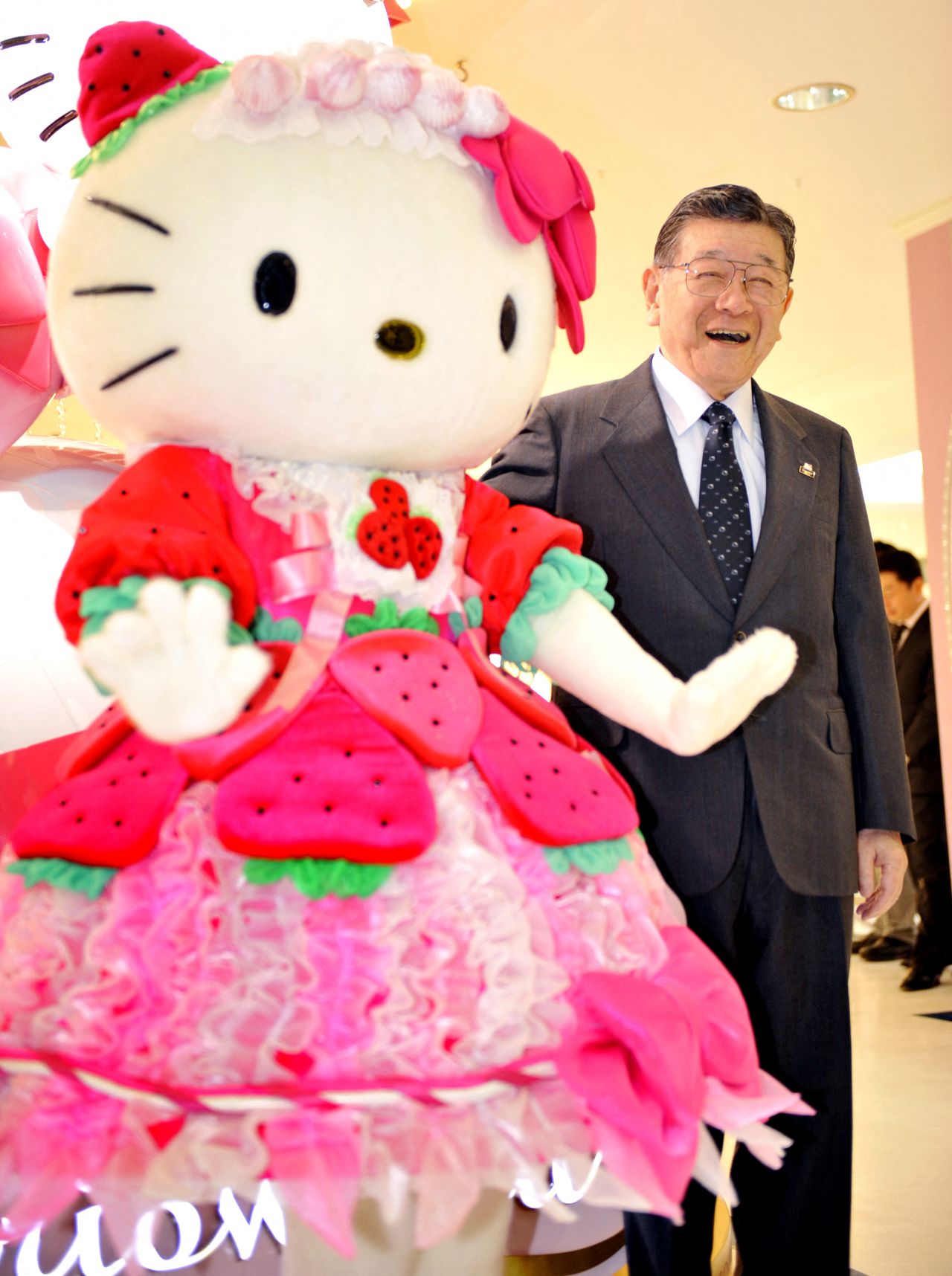
Sanrio CEO Tsuji Shintarō poses with Hello Kitty in October 2009. (© Jiji)
In 1973, the company rebranded to Sanrio, which is said to have come from the words for “saint” and “river” in Spanish. The decision to switch to a Western-sounding name also appears to have been motivated by Tsuji’s desire to follow in the footsteps of Sony and go global. Sony was known as Tokyo Tsūshin Kōgyo until founder Morita Akio rebranded in 1955 with a view to overseas expansion, and succeeded in breaking through in the United States of America.
A Cat with a Bow
In the early 1970s, Sanrio set about designing its own characters after finding that Snoopy, which it bought the license for in 1968, was popular with consumers. In 1974, the young designer Shimizu Yūko came up with a short cat wearing a bow. She felt that Kitty’s mouthless face would make children want to talk to her.
When Sanrio released its first-ever item of Hello Kitty merchandise, a coin purse, the following year, it was an unexpected hit. Initially, the character was unnamed, and merchandise bearing her image was marked simply “Hello!” Later, she was named “Kitty”, after a cat of the same name owned by Alice in one of Shimizu’s favorite books: Through the Looking-Glass, and What Alice Found There, by Lewis Caroll. Later, Kitty was joined by the likes of Mr Melody, Kiki & Lala, Tuxedo Sam, and Keroppi.
In 1978, Sony, the company that Tsuji had looked up to, itself entered the merchandise market with the establishment of subsidiary Sony Creative Products. The 1980s heralded a homegrown character boom in Japan.
While Hello Kitty’s popularity had waned by the late 1970s, Sanrio’s third lead designer, Yamaguchi Hiroko, who was appointed in 1980, helped turn things around. By putting the character in a range of poses that saw her playing tennis and holding a teddy bear, Yamaguchi pulled off a revamp that enabled Kitty to project a fashionable and trendy image.
Sanrio releases five to ten new characters every year (to date there have been 450), although the majority of these disappear from shops after a few years. Hello Kitty can credit innovative design and flexible licensing arrangements for her survival over five decades.
In addition to the capability to create its own designs and a marketing strategy of licensing characters for use on sundry items, Sanrio also benefits from its nationwide franchise. Between 1970 and 1999, the company opened 200 Sanrio stores. After including the company’s presence in department stores, discounters, and other retail outlets, this brought the total number of outlets stocking Sanrio merchandise to several thousand. Thanks to the growth of this distribution and retail network, by the 1990s, Sanrio was said to have an 80 percent share of the novelty gift market.
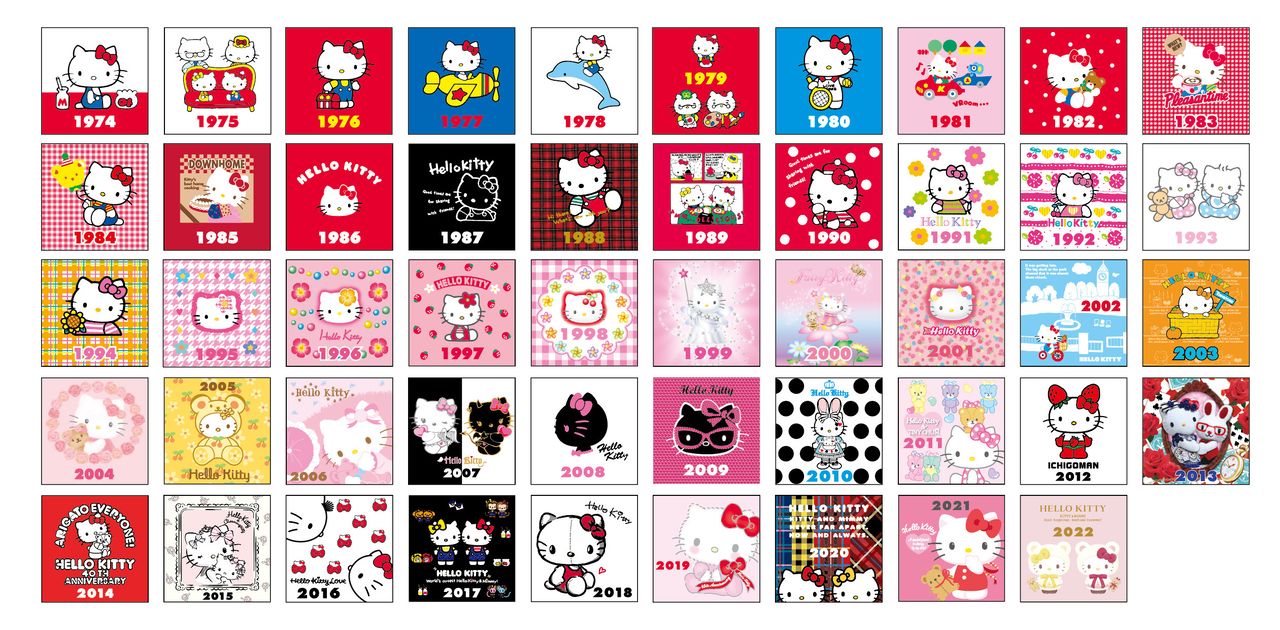
Hello Kitty designs over the past 50 years. (© 2023 Sanrio)
Overseas Success Elusive
In contrast to its stellar domestic performance, however, Sanrio initially struggled overseas. After establishing a US subsidiary in 1974, the company went on to actively expand into Europe and Asia, and even had a foray into Hollywood filmmaking. However, by the time that Tsuji Shintarō sent his son Kunihiko to America in 1986 to be the fourth representative director of the US subsidiary, its cumulative losses had soared to ¥3.6 billion. With the company lacking distribution channels, Kunihiko was forced to load up catalogues and merchandise and tour North America, expanding sales channels through sheer determination.
During this period, the content creator extended its network of Sanrio Gift Gate outlets to inland and regional towns where there was little to do, all the time shipping Sanrio novelties to its retail network. These efforts laid what we might term the first “geological layer” of Hello Kitty’s US strategy. Over time, each generation’s collective memory of the cute Japanese knick-knacks that they played with as children was deposited over the memories of the preceding generation, creating multilayered strata in the collective memory. It was thus that Hello Kitty infiltrated the US market.
In the late 2000s, Sanrio started developing and designing products for the United States market locally, collaborating with luxury jewelry, cosmetics, and fashion brands. This design innovation was well received by the likes of Mariah Carey, Paris Hilton, Katy Perry, and Lady Gaga. All these celebrities remembered falling in love with Sanrio’s cute knickknacks during their childhoods in the 80s and 90s. Collaborations between Hello Kitty and LMVH, Szarkowski, and other luxury brands enabled the generation that fell in love with Sanrio as children to continue to appreciate and show off the brand as adults. This phenomenon combined with the advent of the social media age to create an environment in which celebrities share their love of Hello Kitty by holding and wearing Kitty-branded items, spreading a whole new type of Hello Kitty appeal.
Today, Sanrio operates in over 130 countries and territories. In the year ended March 2004, its overseas sales surpassed ¥10 billion, but a decade later this figure had increased to over ¥30 billion.
Rebounding From 2010s Slump
In 2013, Senior Executive Vice President Tsuji Kunihiko, who had been overseeing Sanrio’s overseas operations, died suddenly at the age of 61. The following January, Tsuji Shintarō’s grandson Tomokuni joined the company. However, after reporting record operating profits in the year to March 2014, the company’s performance began to falter.
After being passed the baton of CEO in 2020, Tomokuni shook up the Sanrio executive by bringing in external talent, and in the process lowered its average age from 65 to 50. In a bid to start growing again, Sanrio embarked on a reform of its corporate culture and structure. The company’s digital business exemplifies this. Sanrio is now part of the Roblox market (an online gaming platform on which users create and share games) and is also advancing projects in the Web 3 business environment (where it operates a virtual version of its Puroland theme park).
With the stroke of a pen, Sanrio opened up licensing arrangements to digital partners and articulated a goal of making consumers increase what it calls their “Sanrio time” (time spent using branded merchandise and watching video games and content featuring Sanrio characters). The company also updated its corporate slogan from Small Gift, Big Smile to One World, Connecting Smiles—both phrases are linked to its corporate ideal of “everyone getting along together.”
The most important thing for Sanrio is that its characters continue to “get along together” in consumer-facing spaces through judicious licensing arrangements with a range of industries. The creator is currently overhauling its licensing arrangements to keep up with the changing times.
In future, we can expect to see Hello Kitty and many other Sanrio characters increase their presence in digital spaces. This was a character with no mouth and no backstory who never appeared in a manga or anime, but she has enjoyed a continued presence in the merchandise market both within Japan and overseas for over 50 years. Perhaps her simplicity is the secret to her success.
In an age overflowing with new kinds of content, there is something relaxing about a fictional character as cute and inobtrusive as Kitty. A placid companion, as Hello Kitty continues to layer strata upon strata of memories for young children, she will continue to be loved.
(Originally published in Japanese on October 11, 2024. Banner photo: A display celebrating Hello Kitty’s fiftieth anniversary at a Japanese festival held in July 2024 in São Paulo, Brazil. © Roberto Casimiro/Fotoarena via Zuma Press/Kyōdō.)

